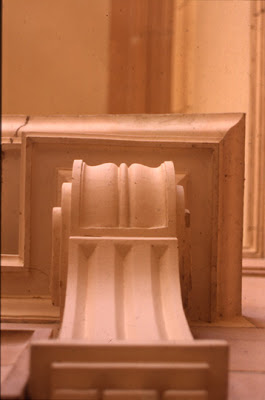Don't stand behind me while I paint
By Al R. Young
One of the unwritten laws of the studio is never to stand behind me when I paint. I'm always backing up (on a sudden and without looking) to take the long view of what's happening to the image on the easel. For every painting session at the easel, I probably walk a mile in the relatively small space in which I work.
For me, the primary reason for using an easel has relatively little to do with applying paint. Instead, it has a great deal to do with the need to easily and quickly view the work from different vantage points, in order to more fully see it and refine it accordingly.
Where and how to situate an easel is far more than a matter of whether its own footprint fits in the floor space available for it, and whether the light falling on the work area meets the artist's needs. The space required for an easel must include the artist's footprints: The space needed for "editing" the image during its creation.
Perspective, in creating a painting, is not just the perspective in the image, but the perspectives from which to view it in order to create it. (Perspectives, incidentally, are not only spatial in nature, but can be mental, emotional, etc., but that is a subject for another post.)
The need for perspectives relates to something W. J. J. Gordon said about creativity: "The most important element in the creative process is Making the Familiar Strange, because scientific breakthroughs as well as visual and literary innovations depend on Strange new contexts by which to view a familiar world." [The Metaphorical Way of Learning and Knowing by William J. J. Gordon (Cambridge, Massachusetts: Porpoise Books, 1971), p. 11 -- While much of the writing in the book is of the case-study persuasion, five pages in chapter 2 present an analogy between an amoeba and the history of British colonies in North America.]
Elspeth talks about this kind of approach to problem-solving in her post entitled "Turning the problem upside down".
Sometimes as a child I would stretch out on the floor and spend a while just staring up at the ceiling, pretending it was the floor, and that I could walk there upside down. (Children are wonderful examples of what it means to see with fresh eyes.)
Sometimes as a child I would stretch out on the floor and spend a while just staring up at the ceiling, pretending it was the floor, and that I could walk there upside down. (Children are wonderful examples of what it means to see with fresh eyes.)
When we look at something primarily for the purpose of naming it, we usually stop looking at it the moment we can "tell what it is" (as these quotation marks indicate, we even talk about this kind of seeing as though it were definitive, as though knowing the name for something were the only thing we need know about it.) But if we can hold onto the childish wonder for the shapes and the colors of what we see -- shapes and colors for which we have no names -- then we can see with an artist's eye.
 |
| Photograph by Ashton Young |
Browse articles by year: 2025 . 2024 . 2023 . 2022 . 2021 . 2020 . 2019 . 2018 . 2017 . 2016 . 2015 . 2014 . 2013 . 2012 . 2011 . 2010 . 2009 . 2008 . 2007 . 2006 . 2005 . 2004 . 2003 . 2002 . 2001 . 2000 . 1999 . 1998 . 1997 . 1996
Browse articles by topic: Art lessons . BenHaven Archives . Blank art diaries . Fine art photography . Framing . Illustration . Inspiration and creativity . Isles of Rune . Limited Editions Collection . My Fathers Captivity . News . Novellas . Oil paintings and prints . Operations announcements . Orders and shipping . Overview . Portfolios . The Papers of Seymore Wainscott . Project commentaries . Recipes by Nancy Young . Recommended reading . Recommended viewing . Temple artworks . The Storybook Home Journal . Tips and techniques . Tools supplies and operations
Browse articles by topic: Art lessons . BenHaven Archives . Blank art diaries . Fine art photography . Framing . Illustration . Inspiration and creativity . Isles of Rune . Limited Editions Collection . My Fathers Captivity . News . Novellas . Oil paintings and prints . Operations announcements . Orders and shipping . Overview . Portfolios . The Papers of Seymore Wainscott . Project commentaries . Recipes by Nancy Young . Recommended reading . Recommended viewing . Temple artworks . The Storybook Home Journal . Tips and techniques . Tools supplies and operations